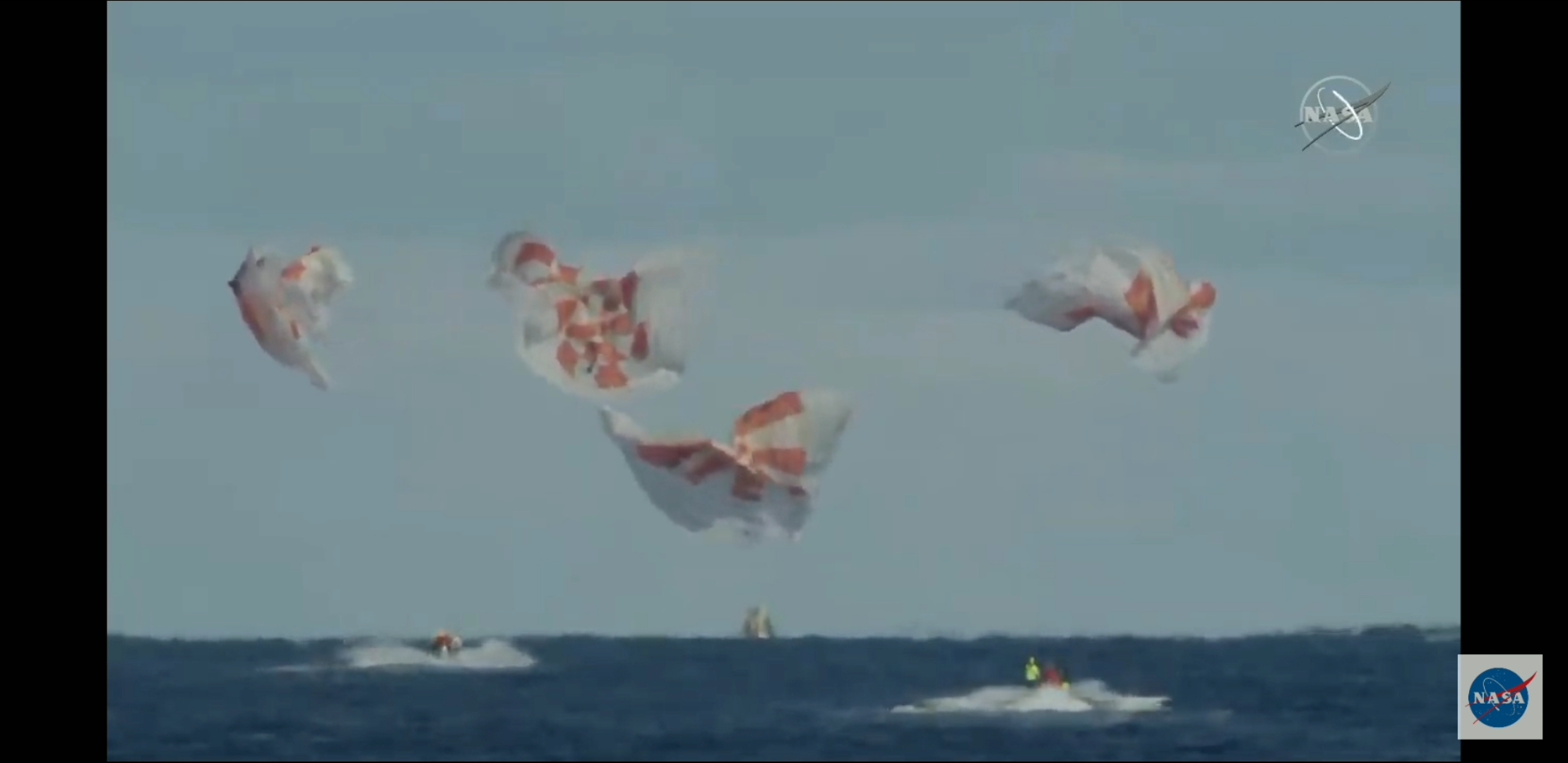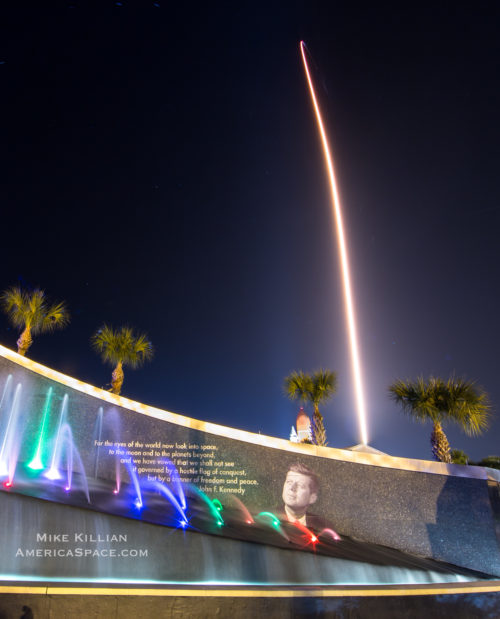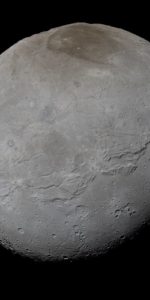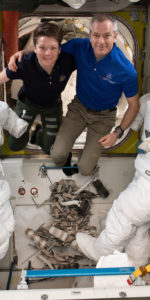
This morning, SpaceX’s first Crew Dragon closed out an incredibly successful maiden voyage to and from the International Space Station (ISS), splashing down gently 230 miles off the coast of Cape Canaveral, Florida at 8:45am EST and wrapping up a week-long uncrewed flight test demonstration mission (Demo-1).
“We were all very excited to see re-entry, parachute and drogue deploy, main deploy, splashdown – everything happened just perfectly. It was right on time, the way that we expected it to be. It was beautiful,” said Benji Reed, director of crew mission management at SpaceX.
Launched atop a Falcon 9 rocket on March 2 at 2:49am EST, the spacecraft and mission teams from SpaceX and NASA were put through the paces to prove out the capsule’s ability to launch a crew, autonomously dock and deliver to the ISS, undock, and make a nominal atmospheric re-entry and splashdown; showing they can safely return a crew to Earth.
Following launch, the spacecraft made 18 orbits of the Earth before docking to the ISS, marking not only the first time an American spacecraft has ever autonomously docked there, but also the first time a spacecraft has used the station’s new international docking adapter, which was delivered on a Cargo Dragon via mission CRS-9 and installed by spacewalkers in August 2016 (read all about that HERE).
Canadian astronaut David Saint-Jacques was actually the first person to ever enter a Crew Dragon in space, and was followed immediately after by Russian cosmonaut and current ISS Commander Oleg Kononenko, both of whom started work taking atmospheric readings and unloading some payload, while wearing protective gear to avoid breathing particulate matter that may have shaken loose during launch.
Joined after by NASA astronaut Anne McClain, the 3 crew members then held a ceremony to celebrate the achievement, each saying a few words, before McClain floated in and became the first American inside a Crew Dragon in space.
During its five days linked to the space station, Crew Dragon was subjected to external photo-documentation, via Canadarm2, and internal inspections by the Expedition 58 team, who focused specifically upon its habitability and the condition of its windows.
Some 400 pounds (180 kg) of supplies and equipment were delivered too, packed behind the Crew Dragon’s seats in a designated cargo area and comprising a set of radiation monitors, together with cold bags for returning science specimens and assorted crew supplies, which include clothes, hygiene items and food for the crew currently on station.

The crew also loaded about 300 pounds of hardware and science aboard Crew Dragon for the trip home, before closing the hatch between it and the ISS mid-day EST on Thursday, 7 March, followed by undocking at 2:30am EST on Friday, March 8th.
It then performed a series of short departure burns to increase the distance between the vehicle and orbiting laboratory, before dumping its trunk, closing its nose cone and firing a 15-minute deorbit burn for the plunge to re-enter Earth’s atmosphere.
Streaking over the southeastern United States and under the eyes of a NASA jet and tracking camera, the spacecraft appeared right where it was supposed to and deployed its drogue parachutes just fine, before deploying the four main parachutes and splashing down on time and on target.
The early-hours landing was dictated in part by the requirement for adequate lighting conditions at the splashdown point, to enable satisfactorily observation of parachute deployment and recovery operations.
SpaceX had two ships waiting to recover Dragon, and before the capsule even touched a wave crews were already speeding to the LZ to get started. They then safed the Dragon and towed it to SpaceX’s recovery ship, Go Searcher, before hoisting it via crane out of the water and onto the main deck of the ship.
A suited-up ‘test dummy’ named Ripley was onboard for the mission too, outfitted with sensors to provide data about potential effects on humans traveling in the spacecraft.
After SpaceX processes all the data, teams will begin refurbishing Crew Dragon for its next mission, an in-flight abort test targeted to take place this summer (read about that HERE).
Demo-2, the first crewed test flight, will then follow, carrying NASA astronauts Bob Behnken and Doug Hurley on the spacecraft’s final flight to certify Crew Dragon for routine operational missions.
“For the first time, we’ve gotten to see an end-to-end test, and so now we’ve brought together the people, the hardware and all the processes and procedures, and we’ve gotten to see how they all work together, and that’s very important as we move toward putting people onboard,” said NASA astronaut Mike Hopkins, who will crew SpaceX’s first operational mission to the space station following Demo-2. “I’m, personally, very anxious to hear how Ripley is feeling after they pull her out of the capsule and get her onto the recovery vehicle.”
Crew Dragon and Ripley are currently expected to arrive in Port Canaveral Saturday evening.
.
.
FOLLOW AmericaSpace on Facebook and Twitter!
.
.






Hello Mark,
One of the problems of the broadcast of the historic Space X splashdown last was that it was not conducted by anyone independent of the organisations behind the event.
As such, they were far too busy congratulating themselves at the time to note the obvious:
That being three problems, one of which could be fatal to astronauts.
One of the four main parachutes, that was initially right of screen kept, with the others, bouncing back and forth from the centre. Eventually this parachute moved from the far right, and crossed over to the other side. A possible fouling potential, but, I acknowledge, there may be systems in place to ensure this fouling potential is alleviated.
When the parachutes were released immediately upon splashdown, one parachute landed flush over the top of the capsule, and wasn’t able to be removed for a very, very long time.
Had this been the Mercury 7, a parachute landing over the capsule in the same fashion would have been fatal to Gus Grissom.
The capsule collection from the ocean, which would have crew in it for the duration of the capsule salvage, took well over an hour. That would be over an hour of sea sickness for a crew that might be coming off six months on the ISS.
To this point not a word was, or has been (to my knowledge), spoken about the potentially fatal parachute flaw, or the extraordinarily long process of capsule salvage.
I do not believe these matters would have been “missed” by independent live media coverage.
But, for me, questions are now raised about Space X’s return to earth protocols.
Yours sincerely
John McPherson
(I am a former journalist and, later, an Associate Lecturer in the School of Tourism and Hospitality Management at SCU (Aust). My duties included the delivery of an annual Space Tourism lecture.
Expecting any commentary during a live event to note these items is somewhat unrealistic. Comments would be pure speculation, and sensationalist. Even the touted “independent coverage” often blathers on and doesn’t see or comment on many many aspects of an event that viewers see, or would like to hear about. It also seems that you are making an argument that nobody was paying attention and did not see, and in fact will not pay any attention due to celebrations. Do you seriously think nobody will review this footage??
You cite 3 ‘problems’ but actually they are 3 things you see that you THINK MIGHT be problems.
#1: I’m not a parachute expert, I have no knowledge of the systems.
#2: This was not Mercury 7.
#3. You assume the recovery of this unscrewed test vehicle mirrors the recovery of a future manned vehicle, and you assume the crew will be seasick. We have no information about the reasons behind the length of the recovery, and we have no way of predicting seasickness of crew.
You have raised at best 1 item, that I suspect is being looked at closely, and I also suspect this was not the first time that type of chute behavior has been seen over the decades.
(I’m NOT a journalist current or former, I work with real machines, people, systems, technology, in positions from grunt to CEO – and have been following the space program since JFK).
Thank you for your comments A Justin. I do not think it unrealistic for observers to mention the issue of the parachute enveloping the capsule, as everyone could see it happening in real time. I too have been following the space program since JFK’s time – not sure of the relevance of that comment.
I too have worked in the tech field, but the relevant issues are that I understand the live capabilities of reportage and I have experience in studying and teaching about the space program.
As for the sea sickness issue, it has always been a concern for NASA, so why not now?